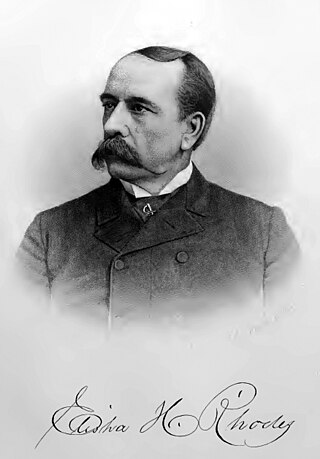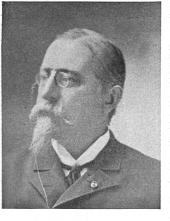Related Research Articles

Elisha Hunt Rhodes was an American soldier who served in the Union Army of the Potomac for the entire duration of the American Civil War, rising from corporal to colonel of his regiment by war's end. Rhodes' illustrative diary of his war service was quoted prominently in Ken Burns's 1990 PBS documentary series The Civil War, read by Chris Murney.

Joseph Bradford Carr was a general in the Union Army during the American Civil War.

The 8th Minnesota Infantry Regiment was a Minnesota USV infantry regiment that served in the Union Army during the American Indian Wars and the American Civil War.
The 9th New Jersey Infantry Regiment was an American Civil War infantry regiment from New Jersey that served from October 1861 through July 1865 in the Union Army. The regiment got its nickname, Jersey Muskrats, during the Battle of Roanoke Island when they successfully "sloshed through shoe sucking mud into waist deep water in "division" formation", giving the regiment a two-company front flanking the enemy. The regiment was the last to leave the state in 1861 but the first to see battle.

Thomas West Sherman was a United States Army officer with service during the Mexican–American War and the American Civil War. While some contemporaries mistakenly identified him as the brother of the more famous General William T. Sherman, modern scholarship notes that the two were not closely related.

The 2nd Rhode Island Infantry Regiment was an infantry regiment composed of volunteers from the state of Rhode Island that served with the Union Army in the American Civil War. They, along with the 1st Rhode Island, wore a very simple uniform. The uniform composed of a dark blue jacket like shirt, tannish grey pants, and a dark blue chasseur kepi. The 2nd Rhode Island also wore havelocks in the beginning of the war, but after finding them useless they discarded them.
George Lafayette Beal was an American politician from the state of Maine who served in the Union Army during the American Civil War.

The 9th New York Infantry Regiment was an infantry regiment that served in the Union Army during the American Civil War. It was also known as the "Hawkins' Zouaves" or the "New York Zouaves."

Charles Robert Woods was a career United States Army officer and a Union general during the American Civil War. He is noted for commanding the relief troops that first attempted to resupply Fort Sumter prior to the start of the conflict, and served with distinction during the war.

John Sanford Mason was a career officer in the United States Army who served in the Indian Wars, Mexican-American War, and as a general in the Union Army during the American Civil War.
Hispanics in the American Civil War fought on both the Union and Confederate sides of the conflict. Not all the Hispanics who fought in the American Civil War were "Hispanic Americans" — in other words citizens of the United States. Many of them were Spanish subjects or nationals from countries in the Caribbean, Central and South America. Some were born in what later became a U.S. territory and therefore did not have the right to U.S. citizenship. It is estimated that approximately 3,500 Hispanics, mostly Mexican-Americans, Puerto Ricans and Cubans living in the United States joined the war: 2,500 for the Confederacy and 1,000 for the Union. This number increased to 10,000 by the end of the war.

John Wainwright was a United States military officer during the American Civil War. A native of Syracuse, New York, he was awarded his nation's highest award for valor, the Medal of Honor, for his "gallant and meritorious conduct" while serving in the Union Army as a first lieutenant with the 97th Pennsylvania Infantry during the Second Battle of Fort Fisher, North Carolina on January 15, 1865.

Charles Augustus Ropes Dimon was a volunteer soldier in the Union Army during the American Civil War. Beginning his service as a private in the 8th Regiment of Massachusetts Volunteer Infantry, Dimon rose through the ranks to become a colonel of a US Volunteer Infantry Regiment and was awarded the honorary grade of brevet brigadier general United States Volunteers, by appointment of President Andrew Johnson on January 13, 1866, to rank from March 13, 1865, and confirmation by the U.S. Senate on March 12, 1866. His success was due in part to the sponsorship of Major General Benjamin F. Butler.
Sylvester Gardner Hill (1820-1864) was a colonel in the Union Army during the American Civil War. He served as a brigade commander during the Red River Campaign and Battle of Nashville where he was killed in action. He received a posthumous appointment as a brevet brigadier general.

The 9th Arkansas Infantry Regiment was a regiment of the Confederate States Army during the American Civil War. It served in the Western Theater, seeing action in the Vicksburg, Tennessee and Georgia campaigns. Due to attrition; the 9th Arkansas was consolidated several times with other Arkansas regiments, finally merging in 1865 into the 1st Arkansas Consolidated Mounted Rifles.

Napoleon Bonaparte McLaughlen was a career United States army officer. He served throughout the American Civil War, winning brevet promotions to Brigadier General of both the U.S. Volunteers and the Regular Army.

Nelson D. Cole (1833–1899), was a United States army officer, businessman, and politician from Rhinebeck, New York.
George Lippitt Andrews was an officer of the United States Army, who commanded the African-American 25th Infantry Regiment for 20 years.

The 48th New York Infantry Regiment was an infantry regiment in the Union Army during the American Civil War.

John S. Poland was a career officer in the United States Army. A Union Army veteran of the American Civil War, he also served in the American Indian Wars and the Spanish–American War. Poland attained the rank of brigadier general and was most notable for his command of the 17th Infantry Regiment and 2nd Division, First Army Corps.